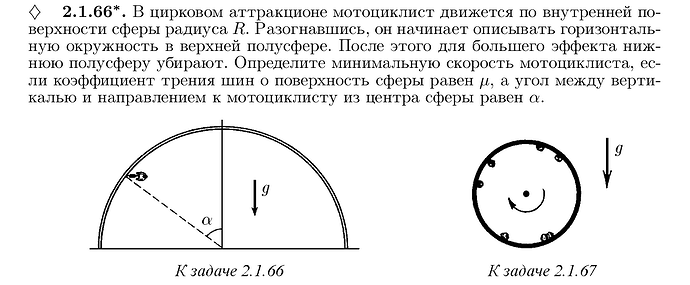To assist with the understanding of the problem, let us clarify the scenario and the relevant physics principles before addressing the equations provided.
The motorcyclist is traversing a flat circular path with radius ( R ). The maximum speed ( v ) without skidding is determined by the balance of the centripetal force required for circular motion and the maximum frictional force that can be provided by the ground. This maximum frictional force is ( \mu N ), where ( \mu ) is the coefficient of friction and ( N ) is the normal force, which is equal to ( mg ) on level ground, where ( m ) is the mass of the motorcycle and ( g ) is the acceleration due to gravity.
For circular motion, the centripetal force ( F_c ) required is ( \frac{mv^2}{R} ). Therefore, at the maximum speed before skidding, we have:
[
\frac{mv^2}{R} = \mu mg
]
From this, we can solve for ( v ):
[
v = \sqrt{\mu g R}
]
Now, to find the minimum distance ( d ) the motorcycle must travel to achieve this speed, we need to consider the work-energy principle. The work done by friction is equal to the change in kinetic energy of the motorcycle. Assuming the motorcycle starts from rest, the kinetic energy at maximum speed is ( \frac{1}{2}mv^2 ), and the work done ( W ) by friction over the distance ( d ) is ( \mu mgd ). Setting these equal:
[
\mu mgd = \frac{1}{2}mv^2
]
Substitute the expression for ( v ) we found earlier:
[
\mu mgd = \frac{1}{2}m(\mu g R)
]
Solving for ( d ) gives:
[
d = \frac{R}{2}
]
Thus, the minimum distance the motorcycle must travel to reach its maximum allowable speed is half the circle’s radius.
Regarding the equations you wrote, they seem to represent a different scenario, perhaps one that involves a motorcycle ascending an inclined plane or another system where gravity and normal force are not aligned. For circular motion on a level ground, the angle ( \theta ) does not enter into the equations in the manner shown. If you are seeking to learn how to solve the differential equations you presented, you might consider a course on differential equations or a physics class that covers mechanics in depth. Online resources such as MIT OpenCourseWare or Khan Academy could also be beneficial.

